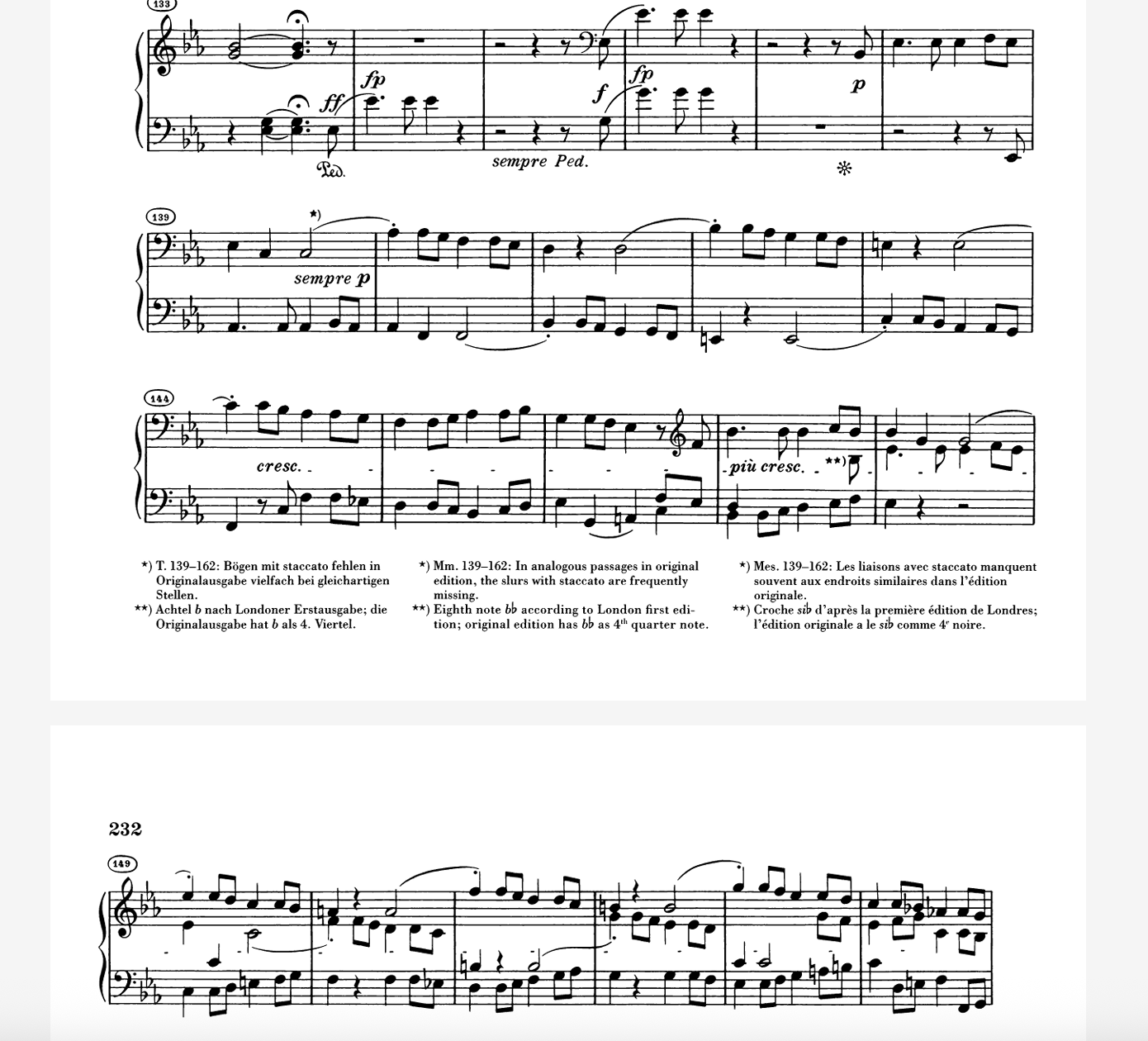Beethoven's Hammerklavier Sonata: A Life-Altering Masterpiece
I was 13 when I first encountered Beethoven's Piano Sonata No. 29 in B-flat major, Op. 106—the "Große Sonate für das Hammerklavier." It wasn't merely listening to music; it was a cognitive expansion, as if my consciousness had suddenly stretched to new dimensions. That moment fundamentally altered my relationship with music, art, and existence itself. What follows is a meditation on how this monumental work has become an integral part of my life and continues to shape my understanding of musical meaning and human experience.
Over the years, I've been privileged to hear it performed live (at least) five times—interpreted by masters like Alfred Brendel, Michael Houston, Yuja Wang, Murray Perahia, and others—each revelation adding new layers to my understanding of this towering achievement. I remember the Yuja recital well because I drove to Düsseldorf and bought some local mustard.
The Initial Encounter
I recall the setting with crystalline clarity. The anticipation before the first note, the gradual realisation that something extraordinary was unfolding, and the overwhelming sensation that I was experiencing more than just a composition, something approaching the metaphysical. The Hammerklavier revealed itself not as a piece to be passively consumed but as a living entity demanding complete intellectual and emotional engagement.
I had, of course, heard of the sonata's legendary difficulty and its position as one of the most challenging works in the piano repertoire until Liszt expanded those boundaries. I had even attempted to play portions of it, despite its formidable length and complexity. Yet nothing could have prepared me for the actual sonic universe it created—a cosmos contained within eighty-eight keys unfolding over approximately 52 transformative minutes.
The First Movement: Ambition Unleashed
The opening movement announces itself with an audacious leap of a tenth, immediately establishing the work's ambitious scope. This is Beethoven at his most assertive, challenging both performer and listener to keep pace with his expansive vision. The exposition unfolds with relentless energy, introducing thematic material of remarkable depth and complexity.
The development section's fughetta captivates me with each listening. This miniature fugue possesses what I can only describe as a "forward-moving" quality that resonates on a profound level. Each entrance of the subject creates an irresistible momentum, an inevitability that carries me forward.

The Fughetta in question
The contrapuntal interplay transcends mere technical display—it's an emotional expression of the highest order, creating a sense of cosmic alignment (and especially does one play B-flat or A-natural in measures 224-226). When the recapitulation finally emerges, it presents the opening theme transformed through the crucible of development. This first movement embodies the Platonic ideal of sonata form, not merely following the structure but revealing why the structure exists.
The Scherzo: Brevity and Absurdity
After the grandeur of the first movement, the Scherzo offers contrast through concentrated brevity. Within its abbreviated span, this movement embraces a controlled absurdity, with rhythmic disruptions and punchy accents creating a sense of ordered chaos. The shifting accent patterns, abrupt dynamic contrasts, and the manic quality of the primary theme generate a controlled turbulence. Here, Beethoven seems to acknowledge the inherent humour in pushing musical boundaries so vigorously—a momentary recognition of the absurdity within his own towering ambition.
This movement has frequently reminded me that profundity and playfulness need not exist in opposition. In moments of excessive seriousness, I recall the Scherzo's impish character. I am reminded to embrace life's occasional absurdities, often while savouring a glass of fine shiraz and gazing upon Lola.
The Adagio: Transcendent Meditation
If the Scherzo represents Beethoven's playful spirit, the Adagio sostenuto reveals his profound capacity for contemplation. This movement unfolds with deliberate patience, each note bearing immense significance. Time seems to dilate, creating a space for reflection rarely achieved in any artistic medium.
During life's difficult passages, this movement has served as my sanctuary. Its searching quality—its willingness to dwell in uncertainty and sorrow without rushing toward facile resolution—has provided a framework for processing grief and contemplating mortality. When Beethoven reaches those climactic fortissimo moments, only to return to quiet introspection, he charts a journey that mirrors our most profound human experiences of suffering and transcendence.
This isn't merely great music—it's music that illuminates the essence of human existence. In this movement, Beethoven achieves what philosopher Theodor Adorno might call "the shudder"—an aesthetic experience so profound that it momentarily dissolves the boundary between subject and object, allowing us to glimpse something beyond ordinary perception.
The Finale: Fugal Transcendence
The introduction to the finale begins with improvisational exploration, gradually coalescing into rhythmic definition. This passage often strikes me as analogous to the creative process itself: navigating through possibilities before committing to a direction.
When the fugue commences, we enter territory that honours Bach while simultaneously extending the fugal form to its conceptual limits. Beethoven acknowledges tradition while transforming it into something uniquely his own. The subject itself, with its ornamental trills and challenging leaps, presents formidable technical demands in isolation. When developed through Beethoven's intricate contrapuntal treatment, it creates a cumulative effect of nearly overwhelming intensity.
What moves me most profoundly about this fugue is its uncompromising nature. Despite its complexity—or perhaps because of it—the movement achieves a kind of spiritual elevation. The struggle becomes meaningful in itself, and the journey takes on significance equal to any resolution. When the final B-flat major chords arrive, they mark not merely the conclusion of a musical structure but the culmination of a philosophical argument expressed through sound.
The Aftermath: Changed Perception
After experiencing a truly transcendent performance of the Hammerklavier, both pianist and audience emerge transformed. We've traversed every conceivable metaphysical realm—from the bold materiality of the opening movement to the controlled chaos of the Scherzo, the spiritual depths of the Adagio, and finally the intellectual and emotional synthesis of the fugue.
We return to the world changed, filled with reverence for Beethoven and for life itself. The boundaries between art and reality blur, and we perceive the world with heightened clarity. Streets appear more vibrant, conversations resonate more deeply, and even ordinary objects reveal previously unnoticed beauty.
A Lifetime Companion
The Hammerklavier has accompanied me through decades, revealing new dimensions with each life stage. What once seemed like technical brilliance has gradually unfolded into a deep emotional and philosophical experience. Passages I initially perceived as merely difficult have revealed their expressive profundity. The work's architecture, once overwhelming, has proven itself to be perfectly logical—even inevitable.
In moments of personal triumph, the first movement's boldness has provided my internal soundtrack. During periods of loss, the Adagio has offered solace; its willingness to dwell in darkness without false comfort providing a quiet strength. And when confronting intellectual questions, the fugue reminds me that complexity doesn't diminish beauty—that difficulty itself can be a form of truth.
Beethoven's achievement in this sonata transcends the musical—it is a work containing multitudes. It sustains a lifetime of engagement without exhausting its riches. The Hammerklavier remains inexhaustible because it speaks to the boundless aspects of human experience: our capacity for joy, our encounters with suffering, our search for meaning, and our aspiration toward transcendence.
When I listen to the Hammerklavier today, I hear not just Beethoven's genius but echoes of my own existence—the person I was when I first encountered it, the countless hours spent in its company, and the insights it has granted me along the way. Few relationships in my life have proven as enduring or as rewarding as my ongoing dialogue with this remarkable work. In its complexity and wholeness, the Hammerklavier remains the truest mirror I've found for the complexity and potential completeness of a human life.
